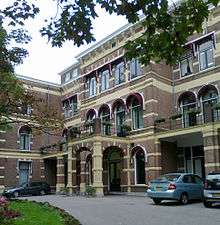Iran–United States Claims Tribunal
The Iran–United States Claims Tribunal (IUSCT) is an international arbitral tribunal that resolves claims between the nationals and governments of the Islamic Republic of Iran and the United States of America. It was established on 19 January 1981 by the Algiers Declarations, an Algeria-mediated agreement between the U.S. and Iran to resolve the Tehran hostage crisis.[1]

Seated in The Hague, Netherlands, the Tribunal hears disputes between both individuals and the two governments. It is composed of nine arbitrators: Three appointed by Iran, three appointed by the U.S., and a further three from third-party countries appointed by the previous six arbitrators.
The Tribunal closed to new claims by private individuals on 19 January 1982, one year after it was established. It received over 3,900 claims and ordered payments totaling over US$3.5 billion; around US$2.5 billion by Iran to U.S. nationals and more than US$1 billion by the U.S. to Iranian nationals.[2] As of 2014, all private claims had been resolved, while several intergovernmental claims are still pending.[3][4]
The IUSCT has been called "the most significant arbitral body in history",[5] and its decisions are considered influential in the areas of investor-state arbitration and state responsibility.[6]
History
The establishment of the Iran-United States Claims Tribunal was among the measures taken to resolve the crisis between Iran and the U.S. arising out of the November 1979 hostage crisis at the U.S. Embassy in Tehran. In response to its nationals being taken hostage by Iranian students, the Carter Administration had frozen all financial assets held by Iran and its nationals.
Algeria intervened as an intermediary between the two governments, consulting with both sides extensively to determine mutually agreeable resolutions. These commitments were recorded in two declarations made on 19 January 1981: the "General Declaration" and the "Claims Settlement Declaration", known collectively as the "Algiers Declarations". Both Iran and the U.S. adhered to the final accord; U.S. President Ronald Reagan, who took office the day after the Algiers Accords, affirmed the agreement, and the U.S. Supreme Court upheld its constitutionality in Dames & Moore v. Regan.[7]
The final accord stipulated that, in exchange for the release of the hostages, the U.S. would terminate litigation against Iran in U.S. courts and release Iranian assets. Pending commercial claims by U.S. nationals against Iran and its State enterprises would be addressed through "binding arbitration" by the Iran-United States Claims Tribunal and "excluded from the jurisdiction of the courts of Iran, or of the United States, or of any other court."
The Tribunal held its first meeting in the Peace Palace on July 1, 1981, moving to its own premises in The Hague the following year.
Jurisdiction and procedure
Pursuant to the Algiers Declarations, the Tribunal has jurisdiction to decide four classes of claims:
- Claims of U.S. nationals against Iran and of Iranian nationals against the U.S. that arise from debts, contracts, and other measures affecting property rights;
- Certain "official claims" between the U.S. and Iranian governments relating to the purchase and sale of goods and services;
- Disputes between Iran and the U.S. concerning the interpretation or performance of the Algiers Declarations; and
- Certain claims between banking institutions.
The Tribunal operates largely in accordance with the arbitration rules of the United Nations Commission on International Trade Law (UNCITRAL), albeit with some modifications.
Claims had to be filed with the Tribunal within one year of its establishment, 19 January 1982; there is no time limit regarding disputes between the two governments concerning matters of interpretation or performance of the Declarations. The majority of claims (approximately 2,800 claims) concerned amounts of less than $250,000, while around 1,000 claims were filed for amounts of $250,000 or more.
The Tribunal consists of nine members, three appointed by Iran, three by the U.S., and three from third-party countries that are appointed by the other six members. Claims are decided by one of the three Chambers of the Tribunal or by the Full Tribunal if it concerns disputes between the two governments or important questions referred to it by the Chambers. Cases between individuals are presided over by three-member chambers, consisting of one Iranian, one American, and one third-party national. Claims are distributed among the Chambers by lot.
Personnel
Judges
Third-country arbitrators
References
- DECLARATION OF THE GOVERNMENT OF THE DEMOCRATIC AND POPULAR REPUBLIC OF ALGERIA (General Declaration), 19 January 1981, www.iusct.net/General%20Documents/1-General%20Declaration%E2%80%8E.pdf
- "NNews". www.iusct.net. Retrieved 2019-06-20.
- "Contact Us". www.iusct.net.
- "Iran-U.S. Claims Tribunal". US State Dept.
- David D. Caron, The Nature of the Iran-United States Claims Tribunal and the Evolving Structure of International Dispute Resolution, University of California at Berkeley (1990), https://scholarship.law.berkeley.edu/cgi/viewcontent.cgi?article=2925&context=facpubs
- Bjork, Charles. "Guides: International Investment Law Research Guide: Iran-United States Claims Tribunal". guides.ll.georgetown.edu. Retrieved 2019-06-20.
- Dames & Moore v. Regan, 453 U.S. 654 (1981)
Further reading
- American Hostages In Iran: The Conduct of a Crisis (Yale 1985)
- Revolutionary Days: The Iran Hostage Crisis and the Hague Claims Tribunal, A Look Back (Juris 1996)
- Symposium on the Settlement with Iran, March 6–7, 1981, Lawyer of the Americas, U Miami J. Int'l Law (Special Issue, Spring 1981).